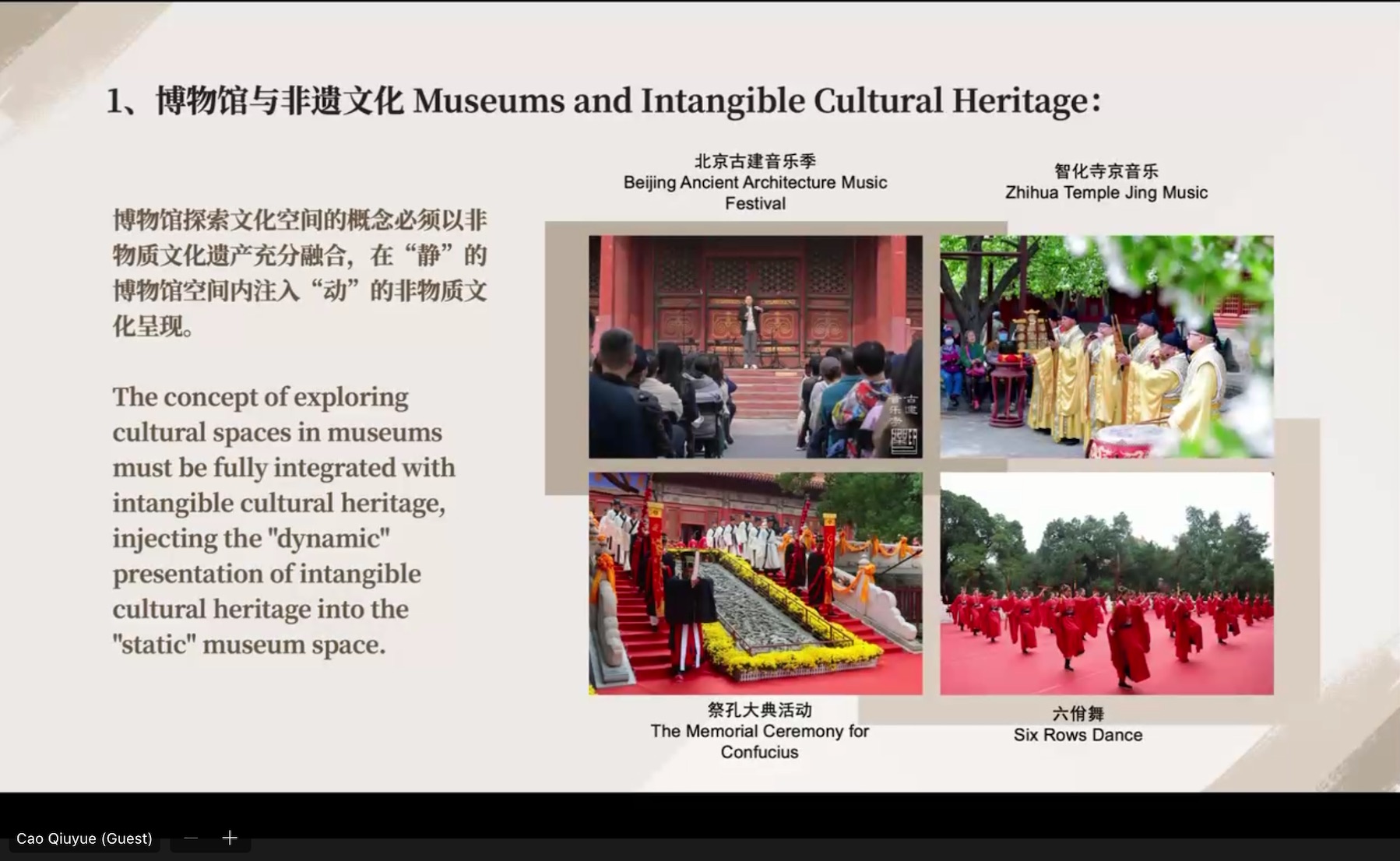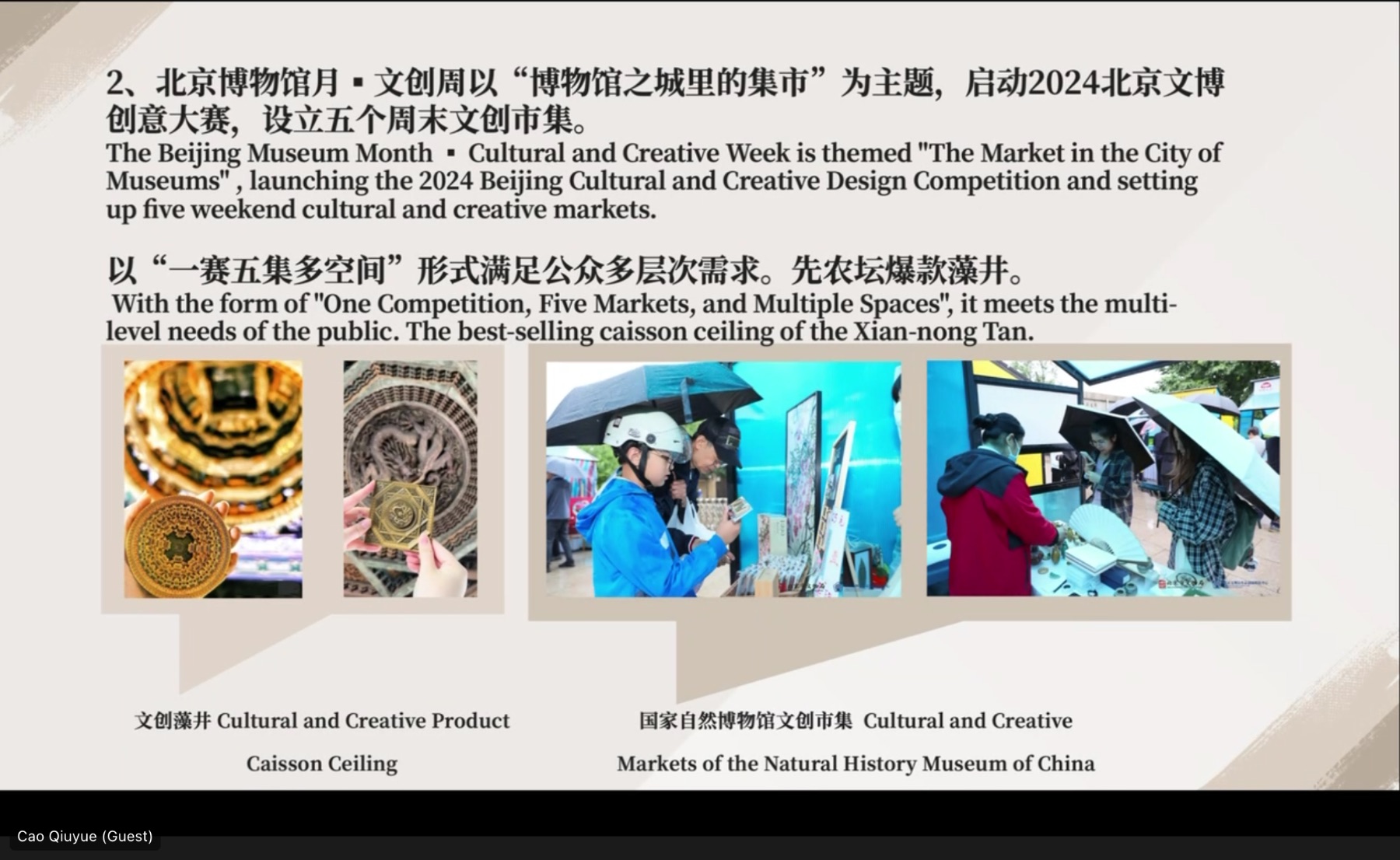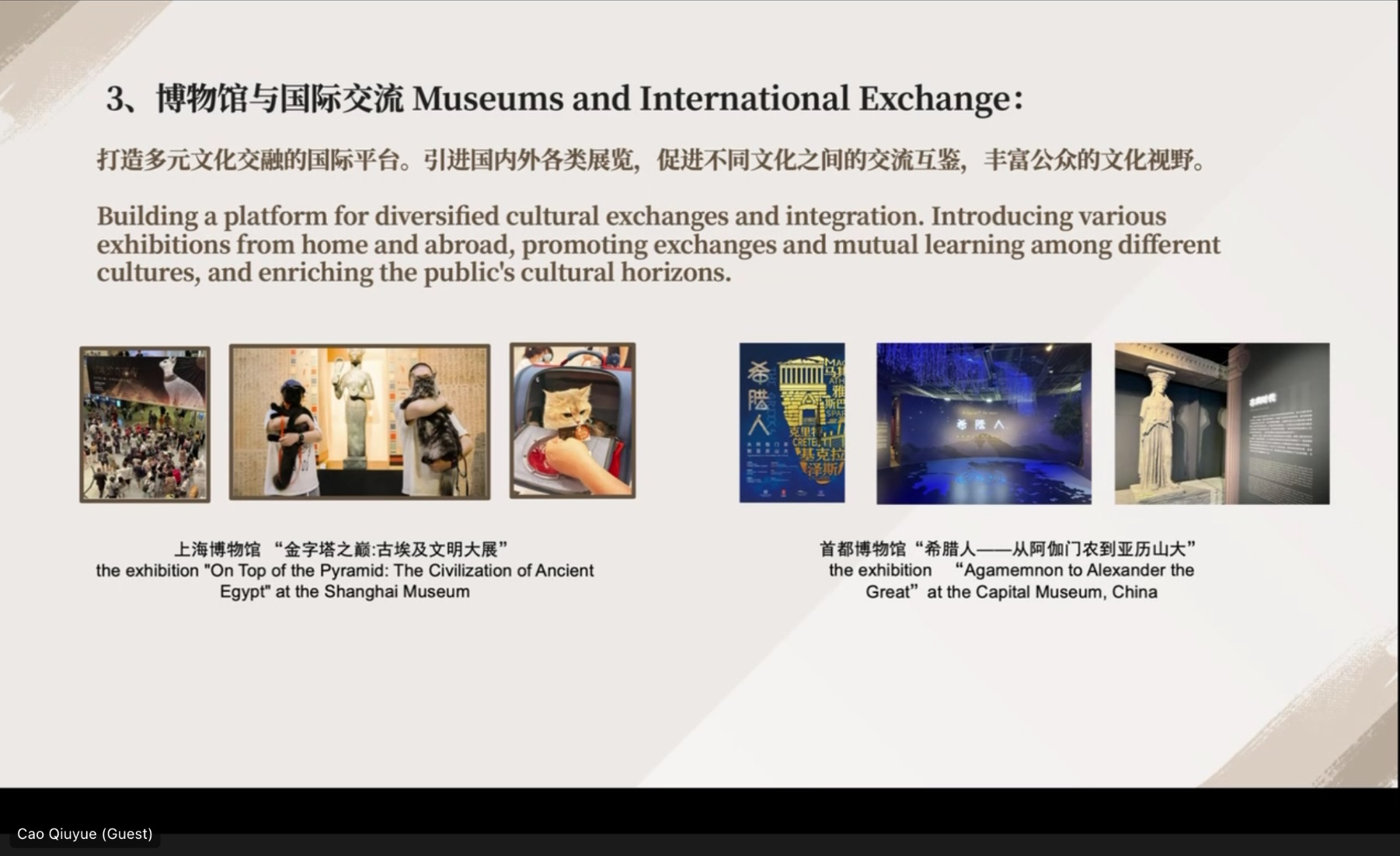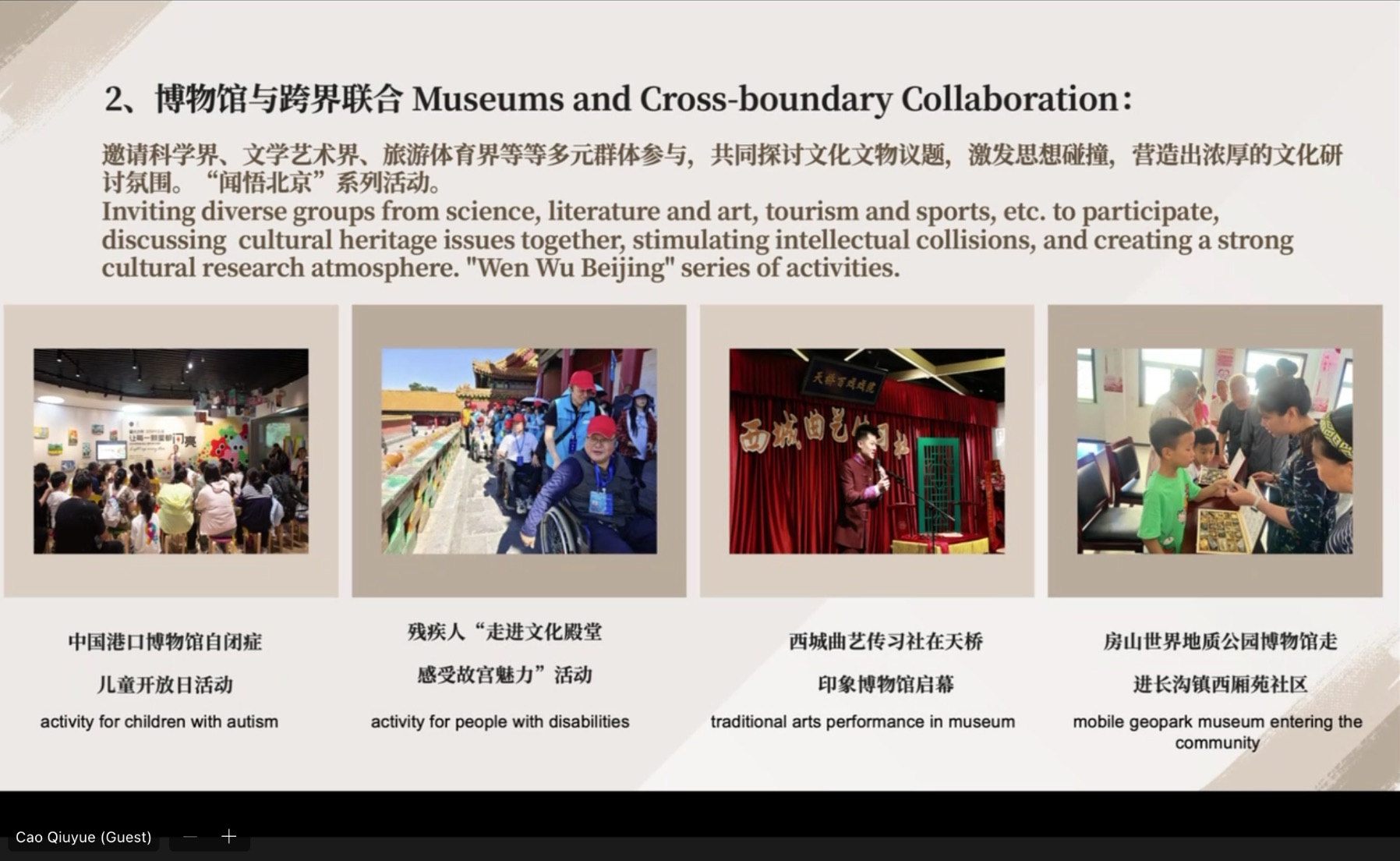Case Study
Beijing Municipal Cultural Heritage Bureau. Modern Museum Governance Innovation
Cao Qiuyue, Beijing Municipal Cultural Heritage Bureau
Background
This case study examines the Beijing Museum Month 2024, an ambitious initiative led by the Beijing Cultural Heritage and Museum Development Center to transform the visitor experience through innovative, inclusive, and participatory cultural spaces. Drawing upon the city’s vision of building a “City of Museums,” the programme explored how exhibitions, creative industries, and cross-disciplinary partnerships could revitalise public engagement with heritage. Through the integration of education, entertainment, and community participation, the initiative redefined museums as dynamic social and cultural ecosystems — fostering accessibility, intercultural dialogue, and sustainable cultural development.
The Beijing Municipal Cultural Heritage Bureau is an administrative agency directly under the Beijing Municipal People’s Government, responsible for the administration of cultural relics and museum undertakings across the city. It undertakes the crucial functions of protecting, managing, utilizing, and supervising cultural relics within the city. As a key department for the capital’s cultural development and the inheritance of historical culture, its work holds strategic significance for preserving the style and features of the ancient capital, passing on the city’s cultural context, and enhancing cultural soft power. According to its official website and public information, its management scope extensively covers immovable cultural relics, archaeological excavation, supervision of the museum industry, management of the cultural relics market, promotion of cultural relics protection, and international exchange and cooperation. By the end of 2023, the total number of registered museums in Beijing had reached 226, forming a diversified system led by state-owned museums, complemented by distinctive industry-specific museums and supported by non-state-owned museums. Beijing has become one of the cities with the largest number of museums in the world, initially establishing an urban cultural landscape characterized by a “Whole-Region Living Museum”, where the ancient and modern coexist harmoniously.
The core function of the Bureau is to fully supervise and manage the cultural relics and museum undertakings in Beijing. Its specific responsibilities cover the following aspects:
- Laws, Regulations, and Planning: Implement relevant national laws and regulations, draft drafts of local regulations of the municipality, and formulate and organize the implementation of development plans for cultural relics and museum undertakings.
- Cultural Relics Protection and Management: Manage world cultural heritage sites and cultural relic protection units, and collaborate with relevant departments in the protection, supervision, and management of famous historical and cultural cities (towns, villages).
- Museum Guidance and Management: This is one of its core functions. By the end of 2023, there were 226 registered museums in Beijing, including 18 national first-level museums, whose quantity and quality rank among the top in major cities across the country and even the world. The Beijing Municipal Cultural Heritage Bureau provides guidance on the professional work of museums in Beijing and is responsible for the management of the identification, registration, loan, transfer, and exchange of cultural relics in museum collections.
- Archaeological Work: Undertake archaeological surveys, prospecting, and excavation work in the municipality.
- Cultural Relics Market Management: Regulate the private collection of cultural relics and their circulation activities in the city.
- Approval and Law Enforcement: Be responsible for the review and approval of matters related to cultural relics and museums, the management of relevant qualifications and certifications, and conduct administrative law enforcement for cultural relics in accordance with the law.
- Promotion and Exchange: Conduct publicity work on cultural relics protection and organise cultural relics exchange and exhibition activities at home and abroad.
Approaches
- Build an efficient, standardized, and modern museum governance system;
- Forge a high-quality and professional talent team;
- Promote the transformation of museums from quantitative growth to qualitative improvement.
Resources
Rethinking Heritage Futures, Online Workshop “Improving the Visitor Experience”, 27 November 2024, Nottingham Trent University (NTU), Communication University of China (CUC).
Projects
1. Strategic Long-Term Planning
Formulate and organize the implementation of medium- and long-term plans such as the Beijing Museum City Construction and Development Plan (2023-2035), and clarify development goals—for example, planning to have more than 460 museums of various types in the city by 2035. At the same time, it has also issued the Beijing Cultural Relics Science and Technology Innovation Development Plan (2025-2035) to drive the high-quality development of cultural relics and museum undertakings through scientific and technological innovation.
2. Systematic Professional Training
- Regular Training Courses: Organize training courses for practitioners in the cultural relics and museum field (such as qualified units for cultural relics protection projects) covering policy theory, laws and regulations, professional knowledge, case studies, and cultural relics safety. For instance, since 2023, the Beijing Regional Museum Director Training Program has been implemented, and through a series of training sessions, the professional awareness and management capabilities of museum directors have been comprehensively enhanced.
- Regular Competitions and Talent Programs: The Beijing Municipal Cultural Heritage Bureau fully implements the “Beijing Museum Craftsmen Project” , organizes special training for high-skilled talents, launches the “Beijing-Tianjin-Hebei Young Craftsman Training Program,” holds consecutive vocational skills competitions, identifies high-skilled talent studios for immovable cultural relics restoration, and innovatively builds a high-skilled talent training system.
- Extensive Training Coverage: The training targets not only relevant units in Beijing but also extends to counterpart support and cooperation regions from time to time, expanding the radiation scope of professional knowledge and promoting regional collaboration and the development of the national cultural relics and museum workforce.
3. Promote Scientific and Technological Innovation and Application
- Digital Technology for Cultural Heritage Protection: Actively apply advanced technologies such as drone aerial photography, laser scanning, and 3D modeling to establish high-precision digital archives for linear heritage sites (such as the Great Wall and the Beijing section of the Grand Canal) and key cultural relics. Construct and operate platforms including the “Great Wall Resource Management and Disaster Monitoring and Early Warning Platform” and the “Beijing World Cultural Heritage Monitoring and Early Warning Platform” to enabling real-time monitoring, risk assessment, and intelligent early warning for cultural heritage sites, thereby enhancing the precision and intelligence of conservation management.
- Smart Services to Enhance Visitor Experience: Establish and continuously optimize the “Beijing Museum Big Data Platform” to integrate museum resource information. Successfully launch the “Beijing Museum Cloud” WeChat Mini Program (with over 1 million users), providing the public with one-stop services such as museum inquiry, reservation, guided tour, and event participation. Encourage and support museums to use technologies such as VR (Virtual Reality), AR (Augmented Reality), and AI (Artificial Intelligence) to innovate exhibition methods, develop immersive experience projects, and enhance the interactivity and attractiveness of exhibitions.
4. Build a Sound Museum System
In accordance with the plan, efforts are made to build an urban museum system characterized by “rational layout, optimized structure, rich content, and distinct features.” Specific goals include fostering 5 “world-class museums,” 50 “excellent museums,” and 100 distinctive small and medium-sized museums. Promote the implementation of the “Whole-Region Living Museum” concept, and conduct overall planning, protection, interpretation, and operation of the entire city of Beijing as a grand, wall-less museum to promote in-depth integration of urban cultural resources and public spacesIn accordance with the plan, efforts are made to build an urban museum system characterized by “rational layout, optimized structure, rich content, and distinct features.” Specific goals include fostering 5 “world-class museums,” 50 “excellent museums,” and 100 distinctive small and medium-sized museums. Promote the implementation of the “Whole-Region Living Museum” concept, and conduct overall planning, protection, interpretation, and operation of the entire city of Beijing as a grand, wall-less museum to promote in-depth integration of urban cultural resources and public spaces
5. Expand Public Cultural Services
- Promote Free Admission: Continuously expand the coverage of public cultural services. At present, more than 100 museums, memorial halls, and art galleries in Beijing have implemented free admission policies. These venues hold thousands of high-quality exhibitions and social education activities every year, serving a total of over 50 million visitors annually, effectively safeguarding the people’s basic cultural rights and interests.
- Organize Characteristic Cultural Activities: Continuously hold brand activities such as “International Museum Day (May 18),” “Beijing Museum Activity Month,” “Beijing Great Wall Cultural Festival,” “Beijing (International) Grand Canal Cultural Festival,” “Beijing Public Archaeology Season,” and “Golden Autumn Cultural Relics and Art Auction Month.” These activities form a cultural feast with themes every season, highlights every month, and participation by all people, creating a strong urban cultural atmosphere.
6. Promote the Development of the Cultural and Creative Industry
Through the regular organization of influential events such as the “Beijing Cultural Relics and Museum Creative Design Competition” and the “Beijing Central Axis Cultural Heritage Inheritance and Innovation Competition,” inspire museums, cultural institutions, design enterprises, and individuals to deeply explore the value connotation of collected cultural resources, develop cultural and creative products that combine cultural taste, practical functions, and market appeal, extend the industrial chain of cultural relics and museums, and enhance the sustainable development capabilities of museums themselves.
7. Promote Resource Sharing and Exchange Cooperation
- Organize Exchanges and Cooperation: Actively build platforms to directly organize or coordinate and guide inter-museum exchanges and cooperation, including joint exhibitions, collection loans, personnel exchanges, and academic seminars, so as to promote the optimal allocation of resources and complementarity of advantages.
- Promote Integration of Central and Local Resources and University Openness: Establish and improve a co-construction mechanism between museums under central administration and Beijing, encouraging their exhibition, education, and scientific research resources to be better integrated into the overall development pattern of the capital’s cultural relics and museum undertakings. At the same time, support and guide university museums to enhance their awareness and capabilities of social services, create conditions for opening to the public, and activate high-quality resources.
Challenges and Successes
Challenges
- High Management Complexity: The museum system is large-scale and diverse in nature (state-owned, industry-specific, non-state-owned), with uneven development levels, making unified management difficult.
- Shortage of Professional Talents: Insufficient reserves of professional talents in fields such as curation, cultural relics restoration, museum education, and digitalisation restrict the high-quality development of museums.
- “Last-Mile” Issue: How to effectively transmit and accurately implement macro-management policies, industry service standards, and technical specifications to every museum, especially small, medium-sized and non-state-owned museums with limited resources and capabilities.
- Ensuring that policy dividends are shared by all, and prevent the gradual decline of management efficiency, is a key issue to be resolved in improving the modernization of industry governance capabilities.
Successes
- Build a modern governance system, forge a professional talent team, and ultimately realise the strategic transformation of the museum undertakings from scale expansion to quality improvement.
- Strengthened the public image of Beijing as a “City of Museums” through immersive, participatory programming.
- Contribute to enhancing China’s cultural soft power and the influence of Chinese culture.
- Fostered interdisciplinary collaboration and community outreach beyond traditional museum walls.
- Enhanced the accessibility and social relevance of cultural heritage.
- Established sustainable mechanisms for feedback, evaluation, and ongoing innovation.
Discussion
As the competent authority for the capital’s cultural relics and museum undertakings, the Beijing Municipal Cultural Heritage Bureau plays a crucial role in protecting the profound historical and cultural heritage of the millennium-old capital, managing and operating a large and diverse museum system, and meeting the people’s growing spiritual and cultural needs.
Facing challenges such as high management complexity, shortage of professional talents, and difficulties in policy implementation, the Bureau is actively responding through a series of practical and innovative measures: strengthening the guidance of strategic planning, implementing systematic talent training, promoting scientific and technological innovation and application, optimizing the layout of the museum system, promoting the opening and sharing of resources, expanding public cultural services, and stimulating the vitality of the cultural and creative industry. Its goals are clear: to build a modern governance system, forge a professional talent team, and ultimately realize the strategic transformation of the museum undertakings from scale expansion to quality improvement. This will help Beijing strengthen its functions as a national cultural center and an international exchange center, and contribute to enhancing China’s cultural soft power and the influence of Chinese culture. Future work will need to be further deepened in areas such as plan implementation, resource integration, refined management, and effectiveness evaluation.



